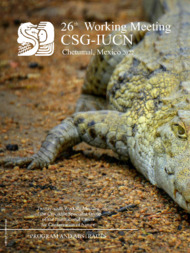SNPs marker toolbox for molecular identification of nominal and candidate species of the genus Paleosuchus.
SNPs marker toolbox for molecular identification of nominal and candidate species of the genus Paleosuchus.
Author(s): BRANDÃO, M. da S.; MUNIZ, F.; HERNÁNDEZ-RANGEL, S.; CAMPOS, Z.; FARIAS, I.; HRBEK, T.
Summary: Recent studies have identified the existence of species complexes in crocodilians, including in the New World Caimaninae. Both species of the genus Paleosuchus are species complexes with three or four species subsumed under the P. palpebrosus epithet and two under the P. trigonatus epithet. From the conservation point of view, it is important to recognize the evolutionary and ecological uniqueness of these lineages, regardless of the taxonomic status they may receive. Candidate species of the genus Paleosuchus have not yet been formally described and therefore do not have diagnostic morphological characters that would allow their identification in nature. This problem motivated us to develop a SNP (Single Nucleotide Polymorphisms) toolkit that enables molecular identification of the nominal and candidate species of Paleosuchus. For this, a ddRADseq (Double Digest RAD-sequencing) protocol was used to obtain reduced representation genome of 20 P. palpebrosus samples, five from each of four lineages ('Amazonia', 'Bolivia', 'Madeira' and 'Pantanal'), and five samples of P. trigonatus, three from the 'Amazon' and two from the 'Guyana' lineage. We selected from between 11 and 15 private SNPs for each lineage that unambiguously assign individuals to one of these lineages. Additionally, we selected 11 mutually exclusive private SNPs that unambiguously assign individuals to one of the two species complexes. The use of the toolkit is affordable and fast-to-apply in comparison to other molecular identification methods, and so it will enable a rapid molecular assignment of individuals to the newly identified lineages of the genus, which may be suffering different degrees of threat. Additional applications of this marker set are: the assignment of zoo specimens, pet trade individuals, museum samples, or degraded samples to source lineages; molecular identification seized animal parts (eg. bush meat); and identification of the origin of illegally traded animals or their by-products (forensic genetics).
Publication year: 2022
Types of publication: Abstract in annals or event proceedings
Unit: Embrapa Pantanal
Observation
Some of Embrapa's publications are published as ePub files. To read them, use or download one of the following free software options to your computer or mobile device. Android: Google Play Books; IOS: iBooks; Windows and Linux: Calibre.
Access other publications
Access the Agricultural Research Database (BDPA) to consult Embrapa's full library collection and records.
Visit Embrapa Bookstore to purchase books and other publications sold by Embrapa.

